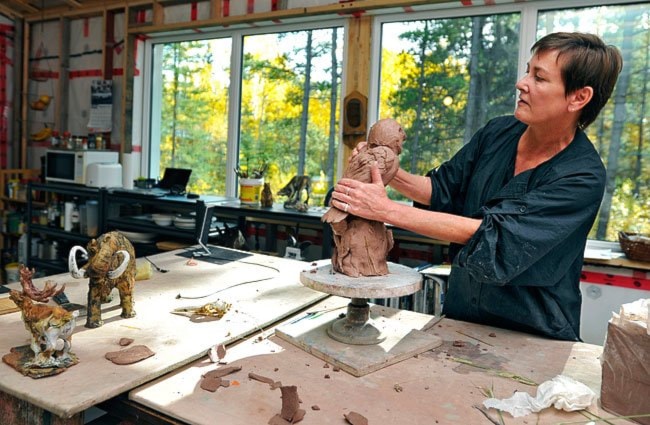Walking into Sandra Grace Storey’s latest exhibit is like walking into a dream.
The Tagish-based sculptor has created a life-size herd of caribou on the walls of the Yukon Arts Centre gallery.
The clay tiles that make the scene evoke the fragmented remains of something lost long ago, carefully pieced back together by a skilled and patient hand. The edges curl out, as if weathered with age.
And while the caribou look ancient, they at the same time feel very much alive.
Animals’ chins jut out from the clay slabs. The caribou appear to interact with each other and the room. Their hides glint with hints of silver and gold.
The tiles that hold the caribou are imprinted with textures, both natural and manufactured, and words. “I belong.” “Remember.” “I am caribou.”
“The caribou wall is like the cave painting full of metaphor and whispers and words,” says Storey.
In the middle of the room sits a large raven made of clay, surveying the scene.
“He’s partly a folklore raven, he’s partly a First Nations raven, he’s partly the raven that gets into my garbage. But he’s there, and he’s a messenger.”
Look up, and the shadow of a raven circling overhead traces a path around the room.
“His presence with the shadow thrower is to tie in the past and present, the real and the metaphoric and the fantasy of the whole situation,” says Storey.
The raven has caught the attention of the two small children sculpted from clay whose eyes are cast up from where they kneel nearby in a midden pile full of treasures.
Storey was inspired by a trip with her son and a friend who discovered an abandoned cabin and were captivated by the artifacts they found there, she says.
“They were just fascinated by them.”
The clay children sit amongst toy figurines of animals that can be found in the Yukon, or that could be found here in the past.
Among them there’s a mammoth, a wolf, a muskox and a bear.
“It’s posing a question, to myself, ‘What does my son inherit, and what do his children inherit?’ No matter who you are in the story, we all come to the same consequence. We all share the consequences of our actions and our decisions,” says Storey.
“I thought of the children being flesh and the caribou being spirit, and the raven being able to inhabit both worlds.”
All the figures are characters in a story, a story that viewers become a part of as they enter the room.
“The thing I like about this scale is that it’s a story that you enter into, and the characters are on the same scale as the viewer,” says Storey.
The size of the work, which covers two full gallery walls with hundreds of clay slabs, came as a surprise to even the artist.
“I never actually saw the whole thing up until two hours before the exhibition opened,” she says. It was, ‘Wow, it’s really big!’ I didn’t expect it was going to be this big. I thought it would cover maybe one wall.”
The tiles were first imagined on rolls of paper in Storey’s cabin studio in Tagish, and then brought to life in pieces.
‘When I saw it all up and lit, I was just really delighted. It was just a delight to see them all coming off the wall, and remembering the individual caribou as I had made them over the past five, six months.”
The exhibit, We Are Golden, will be on display at the Yukon Arts Centre through November 29.
Contact Jacqueline Ronson at
jronson@yukon-news.com
